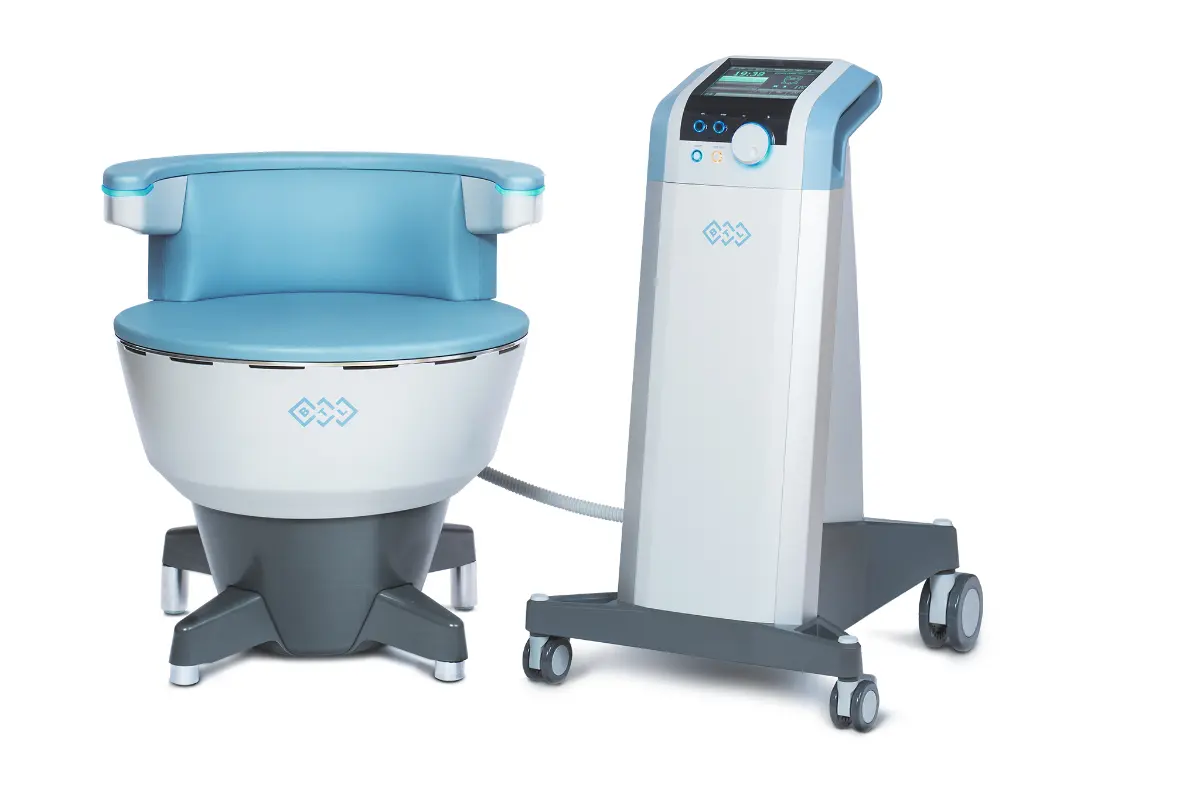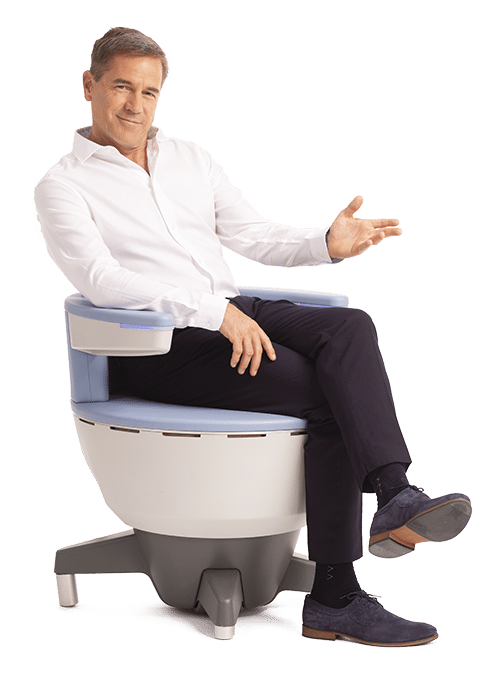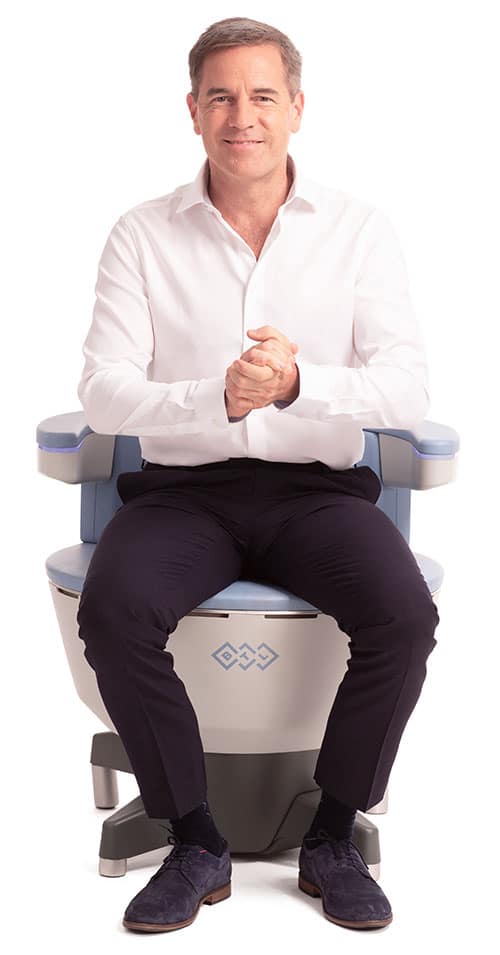Emsella
Emsella is an FDA-cleared device to address urinary incontinence and intimate health.
- Pelvic floor therapy
- No downtime, non-invasive
- Fully clothed, 28-minute sessions
- 95% of patients reported improvement in quality of life
- 75% of women reported not needing pads
- Men reported improvement in Erectile Dysfunction (ED)

FAQs
How does it work?
EMSELLA utilizes electromagnetic energy to deliver thousands of supramaximal pelvic floor muscle contractions in a single session. These contractions re-educate the muscles of incontinent patients.
Does it hurt?
It’s an incredibly comfortable treatment. You will feel consistent tightening of the muscle, but should not feel any pain or discomfort. It’s equivalent to doing 12K Kegels, an impossible task to do on your own or in pelvic floor therapy. Don’t forget, it’s non-invasive and has zero downtime afterward, letting you get back to your life immediately!
How long does the treatment take?
Each treatment takes 28 minutes and is performed twice a week. Depending on your pelvic floor health, we will determine how many treatments you need, but typically 6 treatments.
When do I see results?
Many patients feel results, are stronger, and tighter, after even the first treatment. Results can happen anytime throughout your treatment plan, but ultimate results are achieved 90 days after the final treatment when the muscle has had time to develop.
How much does it cost?
Cost varies depending on your treatment plan. It is necessary to come in for a consultation in order to determine the best package to achieve your body goals. Ultimately we will work with your budget. We have financing and consultation specials available.
Erectile Dysfunction (ED)
Emsella is a non-invasive treatment that utilizes High-Intensity Focused Electromagnetic (HIFEM) technology to stimulate and strengthen pelvic floor muscles. Originally developed for urinary incontinence, it has also been explored for its potential benefits in addressing erectile dysfunction (ED) in men.

Mechanism of Action:
Emsella’s HIFEM technology induces thousands of supramaximal pelvic floor muscle contractions during each session. These intense contractions are designed to strengthen the pelvic floor muscles, which play a crucial role in erectile function by supporting penile rigidity and enhancing blood flow. Improved pelvic floor muscle strength can lead to better control over erections and potentially ameliorate symptoms of ED.
Considerations:
While initial findings are promising, it’s important to note that research on Emsella’s effectiveness for ED is still in its early stages. Men considering this treatment should consult with a healthcare provider to discuss its potential benefits and limitations, and to determine if it’s an appropriate option based on their individual health status and the underlying causes of their erectile dysfunction.
Postpartum Mothers
Postpartum women after having given vaginal birth are at greater risk of urinary incontinence, involuntary leakage of urine. Several factor may contribute to urinary incontinence including weakened pelvic floor muscles, episiotomy, increasing maternal age, birth weight of the infant, BMI, and pregnancy hormonal changes. Between 27 and 33% of postpartum women are affected by urinary incontinence. This affects her physical, psychological and social well-being, reducing her overall quality of life.

Postpartum women after having given vaginal birth are at greater risk of urinary incontinence, involuntary leakage of urine. Several factor may contribute to urinary incontinence including weakened pelvic floor muscles, episiotomy, increasing maternal age, birth weight of the infant, BMI, and pregnancy hormonal changes. Between 27 and 33% of postpartum women are affected by urinary incontinence. This affects her physical, psychological and social well-being, reducing her overall quality of life.
- Emsella chair, a non-invasive treatment designed to strengthen the pelvic floor using high intensity focused electromagnetic technology to stimulate muscles in the pelvic floor.
- It is a twice a week treatment for 3 weeks, 30 minutes per session. You sit fully clothed on the Emsella chair.
- This treatment also reduces frequency and urgency.
- If you are a woman desiring to get pregnant, you might want to increase the strength of your pelvic floor as part of your pre-pregnancy health plan.
Sexual Health in Women
- A toned pelvic floor increases arousal and sensation due to increased blood flow to the genital area.
- When the muscles of the pelvic floor are strong and coordinated, it contributes to more satisfying orgasms.
- If the muscles of the pelvic floor are too tight or hypertonic, this can lead to painful intercourse.
- If the muscles of the pelvic floor are weakened or hypotonic, there is reduced sensation, hence difficulty reaching orgasm.
- Postpartum changes: After childbirth, the pelvic floor can be weakened or injured, affecting sexual function and pleasure.
- Menopause: Those women going through hormonal changes can experience weakened pelvic floor muscles.
Emsella Chair uses high-intensity focused electromagnetic (HIFEM) technology to stimulate deep pelvic floor muscle contractions. When you sit on the chair (fully clothed!), it delivers thousands of supramaximal contractions to your pelvic floor in about 30 minutes.
How does it help sexual health in women?
- Strengthens pelvic floor muscles: Stronger pelvic floor muscles = better blood flow, more support for pelvic organs, and greater control. This can enhance sensation during sex and improve the intensity of orgasms.
- Improves vaginal tightness and tone: Improves vaginal muscle tone, which can lead to increased friction during intercourse and heightened sexual pleasure.
- Reduces urinary incontinence: Since bladder control issues can be super disruptive (and embarrassing) for sexual intimacy, improving continence often boosts sexual confidence — making intimacy less stressful and more enjoyable.
- Boosts blood circulation: The electromagnetic pulses increase circulation to the pelvic region, which supports natural lubrication and sensitivity.
- Postpartum and menopause benefits: Women after childbirth or those going through hormonal changes (like menopause) often experience pelvic floor weakening. Emsella can help “wake up” these muscles, potentially reversing some of the changes that negatively impact sexual function.
(If a woman has tight pelvic floor muscles resulting in dyspareunia, the Emsella chair is not the best treatment option, rather relaxations, deep breathing, Pelvic floor PT.)
What women typically report after Emsella treatments:
- Increased vaginal sensation
- Stronger orgasms
- Less pain during intercourse
- Greater overall satisfaction with their sex lives
- Improved bladder control (a nice bonus!)
Signs your pelvic floor might be too weak (hypotonic):
- Leaking urine when you cough, laugh, sneeze, or jump
- Feeling a “heavy,” “falling out,” or “dragging” sensation in the vagina (possible prolapse)
- Trouble holding in gas
- Decreased sensation during intercourse
- Difficulty achieving orgasm because the muscles can’t contract well
- Frequent urinary leaks or urge incontinence
- Mild lower back pain due to poor core support
Urinary Incontinence in Physically Active Women
- Urinary Incontinence, involuntary loss of urine from the bladder, is common in physically active women.
- Stress urinary incontinence – affects up to 50% of women.
- (SUI), the “complaint of involuntary loss of urine on effort or physical exertion (e.g. sporting activities), or on sneezing or coughing”.
- Stress incontinence is attributed to decreased pelvic floor support resulting from increased intraabdominal pressure during high impact moves such as running or jumping. Stress urinary incontinence was higher with bladder urge.
- Intense physical activity may influence the function of the pelvic floor.
- Stress urinary incontinence is more frequent in young females who practice high-impact sports with a prevalence between 30 and 70%.

Urinary Incontinence in Men
Urinary incontinence in men is less common than in women but still affects a significant number of men, especially as they age.

- Middle age Men: (45-64), the prevalence of UI is about 11%.
- Older men: Among men over 65, UI increases to about 21%, depending on the population studied and the definition of incontinence used.
- After prostate surgery (e.g., prostatectomy for cancer), the rates can be much higher — up to 20% to 30% of men may have persistent incontinence at 1 year post-surgery.
Types of incontinence:
- Stress incontinence (leakage with coughing, sneezing, lifting) is more common after prostate surgery.
- Urge incontinence (strong sudden urge to urinate) is often related to overactive bladder, sometimes associated with aging or prostate issues.
- Mixed incontinence (a combination of stress and urge) can also occur.
The exact frequency can vary depending on the specific age group, health conditions (like diabetes or neurological diseases), and whether the men have had surgeries or radiation therapy.
- Age: The risk escalates with age.
- Prostate Conditions: Issues such as BPH, prostatitis, or prostate cancer treatments can contribute to incontinence.
- Neurological Disorders: Conditions like Parkinson’s disease or multiple sclerosis may affect bladder control.
- Chronic Diseases: Diabetes and other chronic conditions can increase the risk.
- Lifestyle Factors: Smoking, obesity, and a sedentary lifestyle are also contributing factors.
Urinary incontinence (UI) is a common and distressing complication following prostatectomy, significantly impacting men’s quality of life. The Emsella chair, utilizing High-Intensity Focused Electromagnetic (HIFEM) technology, has emerged as a non-invasive treatment option aimed at strengthening pelvic floor muscles to alleviate UI symptoms.
Urinary Incontinence in Peri and Post Menopause Women
Urinary incontinence, including both stress incontinence and urge incontinence are prevalent in peri and postmenopausal women. Research indicates 30-60% of women experience some form of UI.
- Stress Urinary Incontinence (SUI): Leakage with coughing, sneezing, or physical exertion (most common).
- Urge Urinary Incontinence (UUI): Sudden, strong urge to urinate followed by involuntary leakage.
- Mixed Urinary Incontinence (MUI): Combination of stress and urge incontinence.
There are several factors associated with postmenopausal urinary incontinence (UI):
- Hormonal Changes: Estrogen decline affects urethral and pelvic floor function.
- Pelvic Floor Weakness: Due to aging, childbirth history, perineal surgeries, and lifestyle factors.
- Weight Gain: Increased abdominal pressure exacerbates UI.
- Bladder Changes: Reduced elasticity and control over bladder contractions.
The occurrence of UI is inversely related to systemic hormone therapy, regardless of type (oral/transdermal estrogen/progesterone), which is widely used for the alleviation of menopausal symptoms and the restoration of hormonal balance
Additionally, women in this age group often experience urinary frequency especially at night.


